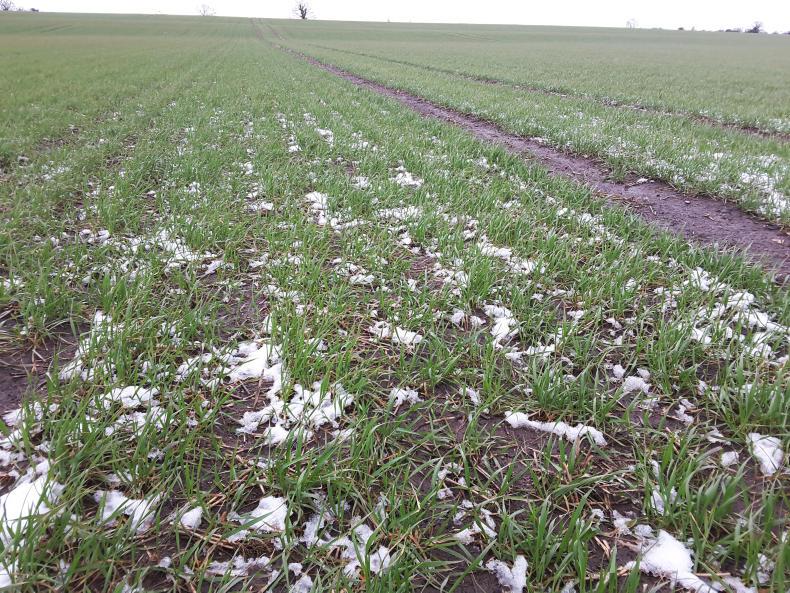This week, we talk to growers from Meath, Cork and Derry. While the prolonged winter has been challenging, most cereal crops have come out the other side in reasonable order. Winter oilseed rape, however, is more variable as poor autumn weather, slugs and pigeons took their toll on crops. Spring ground work has been very limited, with the three growers hoping to make a start in the coming week. Questions are being asked if the spring is running too late for spring beans, wheat and oats in the south and east while in the northern half of the country, favourable weather has paved the way for drainage work to commence.

Clonee , Co Meath
Wet conditions have prevented spring field work on Martin Hoste’s farm in Meath and there have been few opportunities for the ground to dry having received 3in of snow last weekend.
With that said, Martin remains very pleased with his winter wheat crops as they have come through the winter in good order. Growing the varieties Costello and Graham, the crops are free from weeds and are awaiting an application of 15.5.20 with 3% sulphur at 500 kg/ha.
The crops have received an autumn application of Alister Flex at 0.75l/ha, LS Lambda at 0.5 l/ha along with the adjuvant Wetcit at 0.15 l/ha and Savvy at 0.2l/ha to clean up volunteer beans where needed.
Martin is also growing winter oilseed rape (WOSR) on his farm for the first time in 22 years. The crop was heavily grazed by pigeons and remains around GAI 0.5. The crop will receive 15.5.20 with 3% sulphur in the coming days.
The rape hybrid variety PT256 was sown at 1.8kg/ha but was also sown with 3kg/ha of white clover using his Horsch sprinter seed drill. This is very much an experiment to see if the clover would have any yield benefit, explains Martin. The clover was killed off using a combination selective herbicides in the last few weeks.
A few weeks ago Martin had to mow 1.8ha of a heavy infestation of charlock from his WOSR field. The mower was set just above the WOSR plants.
No spring planting or spring ground work has started yet. Martin intends to plant Irina spring barley at 220kg/ha (14st/ac) aiming for 350-400 plants/square metre and Lynx spring beans at 220kg/ha aiming for 35 to 40 plants/square metre.
He sows beans at shallow depths of around 2in to 2.5in to get them above the soil earlier. His cut-off date for planting is around 5 April.
The most pressing job on the farm is fertiliser followed by spring cultivations with his Horsch Tiger.
“Everything is here in the shed. The machinery is all greased and oiled. It’s a bit like the middle of the Mondello grid – we’re all waiting to go but no one can move,” explains Martin.

Mogeely, Co Cork
The slow spring has led to a backlog of field work on Stephen Collins’ farm in east Cork, with ploughing now firmly at the top of the agenda.
While there hasn’t been huge volumes of rain, rainfall has been constant and this has slowed field work. Two inches of snow at the weekend has further left its mark on ground.
Winter crops are around 10 days behind where they should be for this time of year, but Stephen is happy with how they’ve come through the winter. Winter barley is 7-10 days from GS30 and has received 460 kg/ha of 13:7:23+S. The crop has responded well and is due its main split of N at any stage from now on.
Winter wheat has yet to receive any fertiliser while some of the WOSR received the first split 185kg CAN+S/ha three weeks ago, depending on canopy. GAIs currently range from 1.0-2.5.
All of the winter barley received Firebird (0.3 l/ha) and Hurricane (0.1 l/ha) along with manganese in the autumn. Winter wheat was sown late and remains unsprayed at the moment.
Just before the snow, Stephen was busy baling straw, spreading slurry and doing bits of ploughing. East Cork was particularly badly hit with the snow, which has a knock-on effect for field work.
No spring crops have been planted so far but he did manage to get some winter wheat sown (190-200 kg/ha) on 25 February using seed left from 2017.
Spring cropping plans are subject to change on the farm. As they move later into March, there’s a question mark over whether they will sow spring wheat or spring oats. “It’s very much dependent on the weather,” Stephen said.
The most pressing job on the farm at the moment is ploughing, followed by spreading fertiliser. The farm has just 30% of its spring ground ploughed so far. However, crops are advancing towards PGR, T1 and wild oat timings, which add to workload.
“There’s a huge backlog of work. It will be hard to prioritise what job to do first, but there’s nothing you can do. You just have to see what the weather brings,” explains Stephen.

Limavady, Co Derry
After having missed most of the rain and snow, spring ground work now takes top priority on Richard’s farm in the northwest. Ground conditions are good and winter cereal crops are close to mid-tillering. So far, they have received an early application of 10:12:24 (10:5.2:20) with manganese and sulphur and crops responded well to it.
His winter oilseed rape (WOSR) has received 80 l/ha of liquid 14:14:0 (14:6:0), which was applied at sowing using his Sumo Versadrill. His WOSR also received an early application of 10:12:24 (10:5.2:20) two weeks ago.
However, of the 180 acres of WOSR planted last autumn, 70% of the crop was lost due to the poor conditions, late sowing and slug damage. Richard now plans to plant spring oilseed rape: “It’s a lower yielding crop, it’s later to harvest and weed control is difficult, so it wouldn’t be my favourite crop”.
No autumn herbicides were applied on crops last year so Richard is planning to apply 0.3 l/ha of Liberator in the coming days. Regardless, most fields are quite clean so far but annual meadowgrass is expected to appear when growth kicks in.
Richard mainly runs a min-till system but ploughs when conditions dictate, particularly after potatoes. No ground has been ploughed this spring yet but Richard hopes this will change by the end of the week.
A key job to be completed this week is the last of the field drainage work. He aims to lay 1,000 metres of drains annually and hires a tracked drainage machine to do this. As his fields are relatively flat, a laser level guides the machine to work on a 30mm slope across every 100 metres.
He also plans to spread 300 tonnes of poultry manure and to plough it in over the coming weeks. The manure is delivered to his farm and he hires a contractor to spread it. This is his second year to use poultry manure.
Richard isn’t worried about sowing dates thus far: “It’s not late for us yet. It’s been a long time since we’ve been sowing on St Patrick’s Day.”
From the tramlines: follow the progress of 12 tillage farmers nationwide
Monday management: opportunities this week for spring field work






 This is a subscriber-only article
This is a subscriber-only article














SHARING OPTIONS: